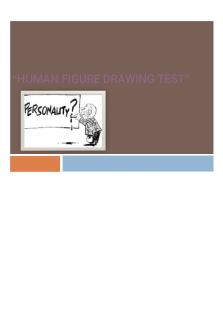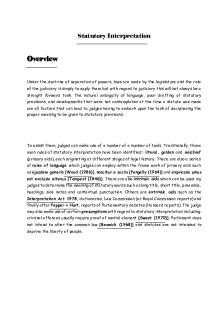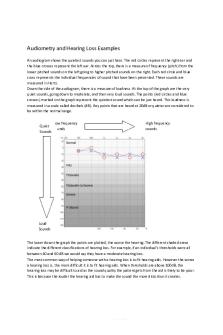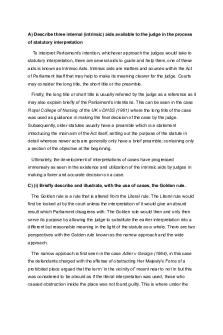Ectrie Regression Interpretation PDF

| Title | Ectrie Regression Interpretation |
|---|---|
| Author | Onyeka Okwuosa |
| Course | Advanced econometric methods & applications |
| Institution | Universiteit Antwerpen |
| Pages | 4 |
| File Size | 91.6 KB |
| File Type | |
| Total Downloads | 92 |
| Total Views | 121 |
Summary
Interpreting correctly based on variables...
Description
How to Interpret Regression Coefficients How one interprets the coefficients in regression models will be a function of how the dependent (Y ) and independent (X) variables are measured. In general, there are three main types of variables used in econometrics: continuous variables, the natural log of continuous variables, and dummy variables. In the examples below we will consider models with three independent variables: X1i a continuous variable ln(X2i ) the natural log of a continuous variable X3i a dummy variable that equals 1 (if yes) and 0 (if no) Listed below are three models. In each case, the right hand side variables are the same, but the dependent variables differ. In each of these regressions, the dependent variable will be measured either as a continuous variable, the natural log or a dummy variable. Define the following dependent variables: Y1i a continuous variable ln(Y2i ) the natural log of a continuous variable Y3i a dummy variable that equals 1 (if yes) and 0 (if no) Below each model is text that describes how to interpret particular regression coefficients. Model 1: Y1i = β0 + β1 X1i + β2 ln(X2i ) + β3 X3i + εi β1 = ∂Y1 /∂X1 = a one unit change in X1 generates a β1 unit change in Y1 β2 = ∂Y1 /∂ ln(X2 ) = a 100% change in X2 generates a β2 unit change in Y1 β3 = the movement of X3 from 0 to 1 produces a β3 unit change in Y1 Model 2: ln(Y2i ) = β0 + β1 X1i + β2 ln(X2i ) + β3 X3i + εi β1 = ∂ ln(Y2 )/∂X1 = a one unit change in X1 generates a 100 × β1 percent change in Y2 β2 = ∂ ln(Y2 )/∂ ln(X2 ) = a 100% change in X2 generates a 100 × β2 percent change in Y2 β3 = the movement of X3 from 0 to 1 produces a 100 × β3 percent change in Y2 Model 3: Y3i = β0 + β1 X1i + β2 ln(X2i ) + β3 X3i + εi β1 = ∂Y3 /∂X1 = a one unit change in X1 generates a 100 × β1 percentage point change in the probability that Y3 occurs β2 = ∂Y3 /∂ ln(X2 ) = a 100% change in X2 generates a 100 × β2 percentage point change in the probability that Y3 occurs β3 = the movement of X3 from 0 to 1 produces a 100 × β3 percentage point change in the probability that Y3 occurs 1
How to Interpret Regression Coefficients
2
An extended example: Below are results from three regressions generated from one data set. The results parallel the three models outlined above. The data set contains responses from a sample of senior citizens (aged 65+) who are all on Medicare. The regressions have three different outcome measures: total expenditures on medical care (totalexp), the natural log of total medical expenditures (totalexp ln) and whether the person has high blood pressure (high bp). For each of these dependent variables, there are three potential independent variables: a continuous variable (age), the natural log of a continuous variable family income (income ln), and a dummy variable (male) that equals 1 if a respondent is male, 0 otherwise. The sample description and the sample means are presented below. storage display variable name type format variable label ----------------------------------------------------------------------------------------------age byte %8.0g age in years totalexp long %12.0g total expenditures on medical care, 2005 high_bp byte %8.0g dummy variable, =1 if have high blood pressure, =0 otherwise income_ln float %9.0g totalexp_ln float %9.0g male byte %8.0g dummy variable, =1 if male, 0 otherwise -----------------------------------------------------------------------------------------------
Variable | Obs Mean Std. Dev. Min Max -------------+-------------------------------------------------------age | 2970 74.0758 6.2289 65 85 totalexp | 2970 8358.247 14109.34 1 235392 high_bp | 2970 0.6704 0.4702 0 1 income_ln | 2970 9.5311 1.3025 1.0986 12.1010 totalexp_ln | 2970 8.0450 1.9049 0 12.3690 male | 2970 0.4101 0.4919 0 1 -------------+--------------------------------------------------------
3
How to Interpret Regression Coefficients ********************************** Model 1 ***********************************
. reg totalexp age income_ln male Source | SS df MS -------------+-----------------------------Model | 4.4037e+09 3 1.4679e+09 Residual | 5.8665e+11 2966 197790222 -------------+-----------------------------Total | 5.9105e+11 2969 199073579
Number of obs F( 3, 2966) Prob > F R-squared Adj R-squared Root MSE
= = = = = =
2970 7.42 0.0001 0.0075 0.0064 14064
-----------------------------------------------------------------------------totalexp | Coef. Std. Err. t P>|t| [95% Conf. Interval] -------------+---------------------------------------------------------------age | 179.7042 41.75361 4.30 0.000 97.83525 261.5732 income_ln | -296.2347 200.2625 -1.48 0.139 -688.9021 96.43277 male | -63.61501 531.2407 -0.12 0.905 -1105.253 978.0227 _cons | -2103.945 3763.827 -0.56 0.576 -9483.922 5276.033 ------------------------------------------------------------------------------
Interpreting the coefficients: age: a one year increase in age will increase annual medical spending by $180 income ln: a 100% increase in income will reduce medical spending by $296 male: male seniors spend $64 less per year on medical care than female seniors ********************************** Model 2 ***********************************
. reg totalexp_ln age income_ln male Source | SS df MS -------------+-----------------------------Model | 195.963729 3 65.3212429 Residual | 10577.1568 2966 3.56613512 -------------+-----------------------------Total | 10773.1205 2969 3.62853502
Number of obs F( 3, 2966) Prob > F R-squared Adj R-squared Root MSE
= = = = = =
2970 18.32 0.0000 0.0182 0.0172 1.8884
-----------------------------------------------------------------------------totalexp_ln | Coef. Std. Err. t P>|t| [95% Conf. Interval] -------------+---------------------------------------------------------------age | .0339304 .0056065 6.05 0.000 .0229374 .0449234 income_ln | .0538694 .0268903 2.00 0.045 .0011438 .106595 male | -.2545062 .0713326 -3.57 0.000 -.3943725 -.1146398 _cons | 5.122521 .5053894 10.14 0.000 4.131571 6.11347 ------------------------------------------------------------------------------
Interpreting the coefficients: age: a one year increase in age will increase medical spending by 3.4% income ln: a 100% increase in income will increase medical spending by roughly 5% male: male seniors have 25% lower medical care spending than female seniors
4
How to Interpret Regression Coefficients ********************************** Model 3 ***********************************
. reg high_bp age income_ln male Source | SS df MS -------------+-----------------------------Model | 5.63145491 3 1.87715164 Residual | 650.661138 2966 .219373276 -------------+-----------------------------Total | 656.292593 2969 .221048364
Number of obs F( 3, 2966) Prob > F R-squared Adj R-squared Root MSE
= = = = = =
2970 8.56 0.0000 0.0086 0.0076 .46837
-----------------------------------------------------------------------------high_bp | Coef. Std. Err. t P>|t| [95% Conf. Interval] -------------+---------------------------------------------------------------age | .0040354 .0013905 2.90 0.004 .0013089 .0067619 income_ln | -.0055152 .0066694 -0.83 0.408 -.0185924 .007562 male | -.0632478 .0176922 -3.57 0.000 -.0979379 -.0285576 _cons | .4499496 .1253485 3.59 0.000 .2041708 .6957284 ------------------------------------------------------------------------------
Interpreting the coefficients: age: a one year increase in age will increase the probability of having high blood pressure by 0.4 percentage points income ln: a 100% increase in income will decrease the probability of having high blood pressure by 0.5 percentage points male: male seniors have about 6 percentage points lower probability of having high blood pressure than female seniors...
Similar Free PDFs

Ectrie Regression Interpretation
- 4 Pages

Regression MCQuestions
- 8 Pages

Regression MCQuestions
- 8 Pages

Regression analysis
- 3 Pages

Week1 Regression
- 114 Pages

HFD Interpretation
- 42 Pages

Statutory Interpretation
- 5 Pages

Statutory Interpretation
- 11 Pages

LINEAR REGRESSION
- 17 Pages

Linear regression
- 10 Pages

Audiogram Interpretation
- 12 Pages

Interpretation schreiben
- 2 Pages

Statutory Interpretation
- 3 Pages

LFT Interpretation
- 5 Pages
Popular Institutions
- Tinajero National High School - Annex
- Politeknik Caltex Riau
- Yokohama City University
- SGT University
- University of Al-Qadisiyah
- Divine Word College of Vigan
- Techniek College Rotterdam
- Universidade de Santiago
- Universiti Teknologi MARA Cawangan Johor Kampus Pasir Gudang
- Poltekkes Kemenkes Yogyakarta
- Baguio City National High School
- Colegio san marcos
- preparatoria uno
- Centro de Bachillerato Tecnológico Industrial y de Servicios No. 107
- Dalian Maritime University
- Quang Trung Secondary School
- Colegio Tecnológico en Informática
- Corporación Regional de Educación Superior
- Grupo CEDVA
- Dar Al Uloom University
- Centro de Estudios Preuniversitarios de la Universidad Nacional de Ingeniería
- 上智大学
- Aakash International School, Nuna Majara
- San Felipe Neri Catholic School
- Kang Chiao International School - New Taipei City
- Misamis Occidental National High School
- Institución Educativa Escuela Normal Juan Ladrilleros
- Kolehiyo ng Pantukan
- Batanes State College
- Instituto Continental
- Sekolah Menengah Kejuruan Kesehatan Kaltara (Tarakan)
- Colegio de La Inmaculada Concepcion - Cebu

